IFComp 2007: Lost Pig
Lost Pig concerns an orc named Grunk, familiar to some parts of the IF community for his Livejournal. Spoilers follow the break.
Lost Pig concerns an orc named Grunk, familiar to some parts of the IF community for his Livejournal. Spoilers follow the break.
A game written in Adrift by someone using the pseudonym “revgiblet”. (The game data contains what might be revgiblet’s real name, but I won’t state it here.) The premise: you’re Death. Spoilers follow the break.
Still trying to get caught up in these posts. Next up is a piece by newcomer Nestor I. McNaugh, concerning an arrogant gentleman thief in a modern setting. (It actually took me a while to realize that it wasn’t a fantasy setting, as the first element of the setting you hear about is a Thieves’ Guild.) Spoilers follow the break.
So, now that the rules of the Interactive Fiction Competition allow blogging about comp games during the judging period, let’s get started. Choosing my first game at random, I got Ghost of the Fireflies by Paul Allen Panks. This did not bode well. Spoilers follow the break.
Read more »
I think most of the people who read this blog are already aware of this, but: the judging period of the 13th Annual Interactive Fiction Competition is now open, and lasts until November 15. You can be a judge, and if you’ve never judged the comp before, I encourage you to give it a whirl. There are 29 entries this year, expected to vary from brilliant to abysmal. This is the smallest batch since 1998, so if you’ve found previous comps daunting, here’s your chance. 29 may still sound like a lot of games to play, but they tend to be short — judges are asked to judge each game after no more than two hours of play, finished or not, and the competitors know this.
Me, I’ll be devoting a large portion of my gaming hours to this for a while, and not blogging about it until the judging period is over, as that would be against the rules. So I don’t know how much I’ll be posting during that time. Maybe I’ll make another go at Pokémon between comp games or something.
[UPDATE 3 October 2007] Correction to the above: the rule against discussing games in a public forum before the judging period is over has been relaxed somewhat this year. Judges are now allowed to publish discussion of the entries as long as they “[m]ake appropriate allowances to hide spoilers, and don’t put spoilers in titles of posts or blog entries.” Now that I know this, I shall do so.
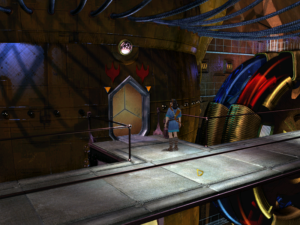 I mentioned before that I own three games that are based on French comic books, but this turns out not to be true. Rather, I own one game based on a French comic book (Druillet’s Salammbo), and two games based on Belgian comic books. No coincidence, either: the same artist provided the source material for both. One of them, XIII, has been off the Stack for some time. The other, Thorgal’s Quest, really should have been finished long ago too — it’s essentially a one-sitting game — but I took a break in the middle, and by the time I got back to it I had activated the nVidia glitch and made the game unplayable. (Even with my new graphics card, there are occasional video problems and even crashes, but nothing that couldn’t be overcome by saving regularly.)
I mentioned before that I own three games that are based on French comic books, but this turns out not to be true. Rather, I own one game based on a French comic book (Druillet’s Salammbo), and two games based on Belgian comic books. No coincidence, either: the same artist provided the source material for both. One of them, XIII, has been off the Stack for some time. The other, Thorgal’s Quest, really should have been finished long ago too — it’s essentially a one-sitting game — but I took a break in the middle, and by the time I got back to it I had activated the nVidia glitch and made the game unplayable. (Even with my new graphics card, there are occasional video problems and even crashes, but nothing that couldn’t be overcome by saving regularly.)
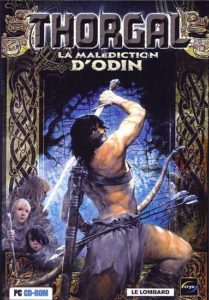
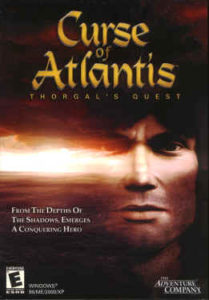 Thorgal’s Quest seems to have been a straight-to-bargain-bin release. I picked it up mainly because the packaging was designed to fool you (successfully, in my case!) into thinking it was part of Cryo’s Altantis series. Apparently the original title is Thorgal: La Malediction d’Odin, but the North American release is Curse of Atlantis: Thorgal’s Quest, with “Atlantis” in much larger letters than “Thorgal”. (I’m calling it Thorgal’s Quest here to split the difference.) It just shows how provincial fame is. According to Wikipedia, Thorgal is “one of the most popular French language comics”, and a best-seller as recently as 2006, but over here, it’s so unknown that a tenuous connection to a semi-obscure adventure game series gets top billing. 1 See also the 1983 laserdisc game Cliff Hanger. No way would that get released today without the name “Lupin III” plastered all over it, and probably “Hayao Miyazaki” as well.
Thorgal’s Quest seems to have been a straight-to-bargain-bin release. I picked it up mainly because the packaging was designed to fool you (successfully, in my case!) into thinking it was part of Cryo’s Altantis series. Apparently the original title is Thorgal: La Malediction d’Odin, but the North American release is Curse of Atlantis: Thorgal’s Quest, with “Atlantis” in much larger letters than “Thorgal”. (I’m calling it Thorgal’s Quest here to split the difference.) It just shows how provincial fame is. According to Wikipedia, Thorgal is “one of the most popular French language comics”, and a best-seller as recently as 2006, but over here, it’s so unknown that a tenuous connection to a semi-obscure adventure game series gets top billing. 1 See also the 1983 laserdisc game Cliff Hanger. No way would that get released today without the name “Lupin III” plastered all over it, and probably “Hayao Miyazaki” as well.
The Atlantis games are first-person adventures based mainly around gratuitous self-contained puzzles slapped arbitrarily on various ancient-civilization backdrops — not the sort of thing I’d easily recommend to others, but sometimes I’m in the mood for it. For example, I was in the mood for it when I bought Thorgal’s Quest, which instead turned out to be a third-person adventure game based mainly around hunting for small objects and occasional archery mini-games.
Thorgal is a Viking warrior who, in the cutscenes, looks kind of like Mick Jagger wearing a tunic and a prominent facial scar. The game starts out with him doing the Odysseus thing, stranded far from home and family by a storm at sea brought on by the wrath of the gods. Enter a magician who shows him a harrowing vision of the future: Thorgal shooting and killing his own son. Thorgal immediately decides that the vision must really be about a shape-shifting villain adopting his guise, and rushes to get home and protect his son before it’s too late, making gamers everywhere shake their heads sadly.
On the way to the lee of the island, where he hopes he can hire a boat despite the storm, Thorgal has an adventure involving some canny bandits who keep the villagers cowed with a fake dragon. Then he almost drowns, only to be whisked away by the same magician to a place called Between Two Worlds, which is your basic Ethereal Void with floating rocks and everything. It was at this point that I really started to suspect that the game was based on a comic book, especially when I met the Guardian of the Keys. Partly it was her apparent role as some kind of cosmic keeper of the balance. Partly it was her appearance: a sexy woman with vivid magenta skin wearing basically nothing but strategically-placed locks of hair. But mainly it was the way that Thorgal already knew her from previous adventures. You could practically see the captions referencing back issue numbers.
Before the Guardian of the Keys can send Thorgal back home, he has to pass a trial involving an interactive representation of his past. And it is here that I learned of his extraterrestrial heritage.
Seriously, now, this has got to seem less bizarre to a player who’s familiar with the source material. It makes me wonder how certain other adaptations I’ve played must seem to outsiders.
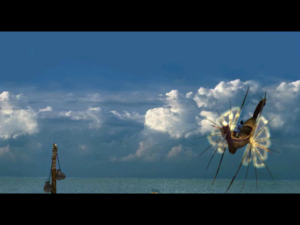 It’s also at this point that the Atlantis material creeps in and provides Cryo an excuse to re-use their Altantean skyboat model. Thorgal’s spacefaring parents, it seems, are descendants of people who fled dying Atlantis for the stars centuries ago. Based on what I’ve seen online, I’m not at all convinced that this is canon. It might just be Cryo winking at the fans, much like the Sam and Max cameos in the old Lucasarts games.
It’s also at this point that the Atlantis material creeps in and provides Cryo an excuse to re-use their Altantean skyboat model. Thorgal’s spacefaring parents, it seems, are descendants of people who fled dying Atlantis for the stars centuries ago. Based on what I’ve seen online, I’m not at all convinced that this is canon. It might just be Cryo winking at the fans, much like the Sam and Max cameos in the old Lucasarts games.
I won’t say much more about the story — Thorgal does get home, and the prophecy does come true but not in the manner anticipated, just like you’d expect. All in all, the production is a bit amateurish. There’s some very nice art in the backdrops, but there are also places where the hand-drawn bits are too visible and don’t mesh with the 3-D models well. The story is completely linear, even in some cases blocking actions for no logical reason until you’ve clicked on an NPC often enough to get all his scripted dialogue (even if the last bit is just “Farewell and good luck, Thorgal” or something.) It’s far from the worst adventure game I’ve played, but it’s clearly built for Thorgal fans, who are expected to be a little forgiving.
| ↑1 | See also the 1983 laserdisc game Cliff Hanger. No way would that get released today without the name “Lupin III” plastered all over it, and probably “Hayao Miyazaki” as well. |
|---|
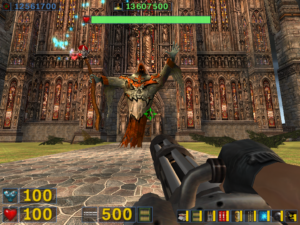 It turns out that the final levels shed the halloween motif pretty quickly and settle into something more like the knightly stuff I was expecting. Not that this has a very great effect on on the game — the monsters are the same as always, and not even reskinned. But the ultimate goal is the Holy Grail (which helps you get a spaceship somehow), and the final boss is a gray-robed wizard-looking guy, albeit one who’s 80 feet tall according to the stats provided in-game. His schtick is that he summons random assortments of the standard monsters, which makes for a difficult fight until you find out about the cheap trick that lets you take him down with near absolute safety. Something of a letdown, but then, the end boss in Serious Sam: The First Encounter is a really tough act to follow.
It turns out that the final levels shed the halloween motif pretty quickly and settle into something more like the knightly stuff I was expecting. Not that this has a very great effect on on the game — the monsters are the same as always, and not even reskinned. But the ultimate goal is the Holy Grail (which helps you get a spaceship somehow), and the final boss is a gray-robed wizard-looking guy, albeit one who’s 80 feet tall according to the stats provided in-game. His schtick is that he summons random assortments of the standard monsters, which makes for a difficult fight until you find out about the cheap trick that lets you take him down with near absolute safety. Something of a letdown, but then, the end boss in Serious Sam: The First Encounter is a really tough act to follow.
Looking back on the whole game, how would I describe it? Oddly medatative. The bulk of the player’s time is spent on chaotic battles in open areas, which is the kind of action that mainly engages the lower brain functions, leaving the player’s thoughts free to wander. Sometimes this means I was thinking about tactics — deciding which weapon to use, whether to seek cover, and so forth — but by the end, I had pretty much got that down. There are only so many permutations the game supports, and by the end, you’ve seen them all several times. I suppose most FPSes deal with this by varying the environment a lot, adding in puzzles and platformer sections if necessary. But Sam, especially toward the end, mainly plays to its strength: chaotic battles in large, open environments.
So, do I want to continue on to Serious Sam 2? Maybe, eventually. There are other FPS games on the Stack, and a distinct possibility that I’ll be sick of them before I get through them all.
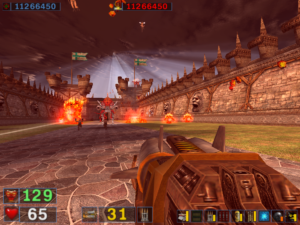 I’m about halfway through the final level now, having finished the biggest, most elaborate courtyard battle yet, with close to 500 monsters of every kind. At one point Sam says “Never underestimate the power of stupid things in large numbers.” It could be the game’s motto.
I’m about halfway through the final level now, having finished the biggest, most elaborate courtyard battle yet, with close to 500 monsters of every kind. At one point Sam says “Never underestimate the power of stupid things in large numbers.” It could be the game’s motto.
There were basically two pauses in this battle where I needed to advance to the next location trigger before more enemies would spawn. (Presumably trying to just run to the end would activate them all at once.) Naturally I saved at these junctures, but in such a long stretch of peril, just two saves wasn’t nearly enough for me. So I wound up using the quicksave key a lot in the middle of dodging fire. Now, I don’t like doing this. Not only does it split up the action and draw away from the flow, it’s just too risky: fairly often, you wind up quicksaving a split-second before something kills you from behind. But Serious Sam has a nice way around that: instead of just one quicksave slot, it has eight, cycling to the next one on every save. The quickload button always loads the most recent quicksave, but you can access all eight from the main menu, so occasional bad timing doesn’t hurt so much. I think this is a sign that the designers had mid-fight quicksaving in mind, that they consider it okay. There’s sort of an implicit bargain there: we get authorial permission to engage in behavior that’s considered borderline cheating by many, and in return the designers get our permission to put us through really long unrelieved action sequences.
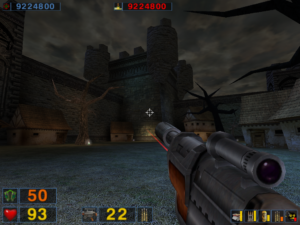 The third segment of Serious Sam: The Second Encounter takes place around a bunch of castles in eastern Europe. I knew when I got the game that there was a section with European castles, and I expected it to be presented in the usual vaguely-chivalric fantasy vein. But no, this is Eastern Europe 1 Exactly where in Eastern Europe is unspecified. But he year is given as 1138 AD, which probably means it’s in modern-day Thxylvania or something. , which has a whole different set of tropes. The styling goes dark and gothic, and the background music turns into stereotypical old-fashioned B-movie creepshow stuff. How stereotypical? It’s based on the exact same four-note organ motif as the theme to Buffy.
The third segment of Serious Sam: The Second Encounter takes place around a bunch of castles in eastern Europe. I knew when I got the game that there was a section with European castles, and I expected it to be presented in the usual vaguely-chivalric fantasy vein. But no, this is Eastern Europe 1 Exactly where in Eastern Europe is unspecified. But he year is given as 1138 AD, which probably means it’s in modern-day Thxylvania or something. , which has a whole different set of tropes. The styling goes dark and gothic, and the background music turns into stereotypical old-fashioned B-movie creepshow stuff. How stereotypical? It’s based on the exact same four-note organ motif as the theme to Buffy.
A funny thing about the music in this game: it’s tied to the intensity of the action. I think each level has three main pieces of background music (excluding special areas with their own music): a sedate and almost ambient one for solitary unmolested exploration, a more uptempo one with more instruments for minor encounters, and one with electric guitars added for pitched battles. The funny thing about this is that the background music actually gives you information. Sometimes your first clue that you’re being attacked is that the music kicked up a gear. Likewise, when you’re finishing a battle, you can tell by the music when you’ve downed the last foe. It reminds me of Jaws (or rather, since I haven’t actually seen Jaws, it reminds me of the jokes about Jaws), how the shark’s presence was always signalled by the soundtrack before you saw it. But usually, in a movie, only the audience is aware of the soundtrack, so there’s no chance that the hero will notice the monster theme and react to it. In my hands, Sam varies his behavior in response to the music all the time.
| ↑1 | Exactly where in Eastern Europe is unspecified. But he year is given as 1138 AD, which probably means it’s in modern-day Thxylvania or something. |
|---|
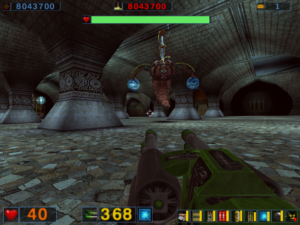 Another day, another insanely difficult boss monster. The Babylon segment of Serious Sam: The Second Encounter ends in a fight with a colossal cyborg insect larva that hangs from a track in the ceiling and moves like a rook on a chessboard, firing energy blasts and emitting small explosive offspring. It’s got enough hit points that I quickly ran out of the ammo for the best weapons while fighting it — there are some ammo packs that spawn during the fight, but getting them involves taking your attention away from the monster, which is risky. So I wound up using most of my weapons against it (with the exception of the hand-to-hand weapons, the knife and the chainsaw, which are useless here — and nearly everywhere else).
Another day, another insanely difficult boss monster. The Babylon segment of Serious Sam: The Second Encounter ends in a fight with a colossal cyborg insect larva that hangs from a track in the ceiling and moves like a rook on a chessboard, firing energy blasts and emitting small explosive offspring. It’s got enough hit points that I quickly ran out of the ammo for the best weapons while fighting it — there are some ammo packs that spawn during the fight, but getting them involves taking your attention away from the monster, which is risky. So I wound up using most of my weapons against it (with the exception of the hand-to-hand weapons, the knife and the chainsaw, which are useless here — and nearly everywhere else).
The weapons in Serious Sam mainly follow the standards laid down by Doom and followed by countless FPS games: chainsaw, pistol, shotgun, machine gun, rocket launcher, grenade launcher, energy weapon. The BFG is replaced by “serious bombs”: like classical videogame smart bombs, they kill everything in the area except the player and certain boss monsters. This isn’t as useful as it sounds, because you can only carry three at once, and the toughest battles in this game have more than three waves of monsters. Add to this set the sniper rifle, the flame thrower, and the SBC cannon.
It’s strange to think that there wasn’t a sniper rifle in Doom or even Quake — today, it seems like one of the basic ubiquitous FPS weapon types, just as much as the shotgun. I wonder if there are any more basic weapon types that haven’t been discovered yet? Things that fill a genuinely new gameplay niche, I mean, and aren’t just gimmicks. It seems like there’s been less innovation there than for weapons in non-FPS games. Duke Nukem gave us bombs that you could lay as traps, and Unreal gave us projectiles that bounce off walls, but those are basically just extensions of what’s implicit in Quake‘s grenade launcher.